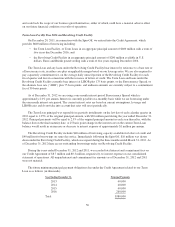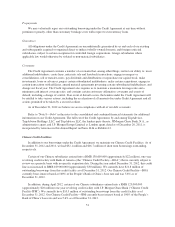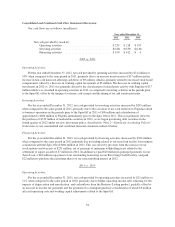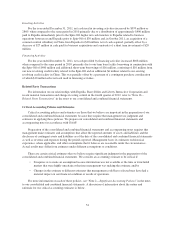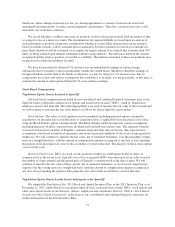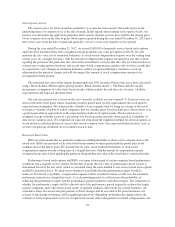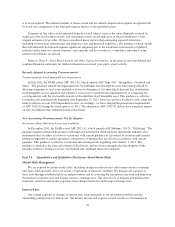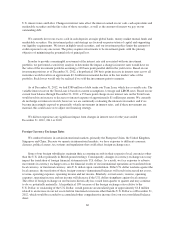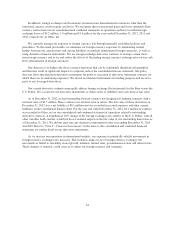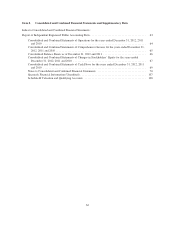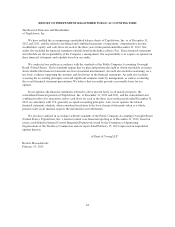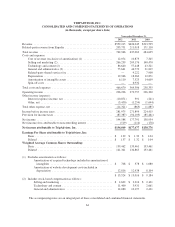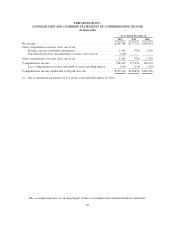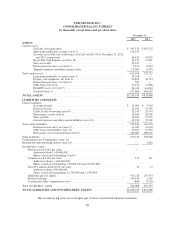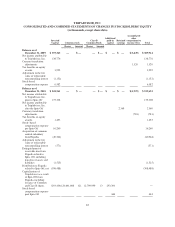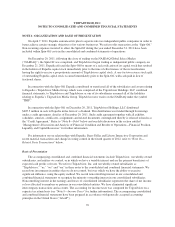TripAdvisor 2012 Annual Report Download - page 70
Download and view the complete annual report
Please find page 70 of the 2012 TripAdvisor annual report below. You can navigate through the pages in the report by either clicking on the pages listed below, or by using the keyword search tool below to find specific information within the annual report.U.S. interest rates and Libor. Changes in interest rates affect the interest earned on our cash, cash equivalents and
marketable securities and the fair value of those securities, as well as the amount of interest we pay on our
outstanding debt.
We currently invest our excess cash in cash deposits at major global banks, money market mutual funds and
marketable securities. Our investment policy and strategy are focused on preservation of capital and supporting
our liquidity requirements. We invest in highly-rated securities, and our investment policy limits the amount of
credit exposure to any one issuer. The policy requires investments to be investment grade, with the primary
objective of minimizing the potential risk of principal loss.
In order to provide a meaningful assessment of the interest rate risk associated with our investment
portfolio, we performed a sensitivity analysis to determine the impact a change in interest rates would have on
the value of the investment portfolio assuming a 100 basis point parallel shift in the yield curve. Based on our
investment positions as of December 31, 2012, a hypothetical 100 basis point increase in interest rates across all
maturities would result in an approximate $2.3 million incremental decline in the fair market value of the
portfolio. Such losses would only be realized if we sold the investments prior to maturity.
As of December 31, 2012, we had $380 million of debt under our Term Loan, which has a variable rate. The
variable interest rate on the Term Loan is based on current assumptions, leverage and LIBOR rates. Based on our
current loan balance through December 31, 2012, a 25 basis point change in our interest rate on the Term Loan
would result in an increase or decrease to interest expense of approximately $1 million per annum. We currently
do not hedge our interest rate risk; however, we are continually evaluating the interest rate market, and if we
become increasingly exposed to potentially volatile movements in interest rates, and if these movements are
material, this could cause us to adjust our financing strategy.
We did not experience any significant impact from changes in interest rates for the years ended
December 31, 2012, 2011 or 2010.
Foreign Currency Exchange Rates
We conduct business in certain international markets, primarily the European Union, the United Kingdom,
Singapore and China. Because we operate in international markets, we have exposure to different economic
climates, political arenas, tax systems and regulations that could affect foreign exchange rates.
Some of our foreign subsidiaries maintain their accounting records in their respective local currencies other
than the U.S. dollar (primarily in British pound sterling). Consequently, changes in currency exchange rates may
impact the translation of foreign financial statements into U.S. dollars. As a result, we face exposure to adverse
movements in currency exchange rates as the financial results of our international operations are translated from
local currency, or functional currency, into U.S. dollars upon consolidation. If the U.S. dollar weakens against the
local currency, the translation of these foreign-currency-denominated balances will result in increased net assets,
revenue, operating expenses, operating income and net income. Similarly, our net assets, revenue, operating
expenses, operating income and net income will decrease if the U.S. dollar strengthens against local currency.
The effect of foreign exchange on our business historically has varied from quarter to quarter and may continue
to do so, potentially materially. A hypothetical 10% increase of the foreign exchange rates relative to the
U.S. Dollar, or weakening of the U.S. Dollar, would generate an unrealized gain of approximately $1.8 million
related to an increase in our net assets held in functional currencies other than the U.S. Dollar as of December 31,
2012, which would be recorded to accumulated other comprehensive income (loss) on our consolidated balance
sheet.
60


